Yes it does and really thinking about it now im not sure which directions I should go as 8124 intake and a mild cam would fit the NA setup but I am 90% sure I am fitting that blower on this winter so intake manifold and cam option could possibly be different, especially if I do as you say and gear up.Well I’ll say this, I currently have 4.30 gears with a TR3650 with a 3.38 first gear; that’s not too far off what a early M5R2 with a 3.75 first and 4.10s would be mathematically. 3.90s would be a wash essentially and 3.73s would be a good all rounder too.
Blower obviously changes the equation quite a bit though
You are using an out of date browser. It may not display this or other websites correctly.
You should upgrade or use an alternative browser.
You should upgrade or use an alternative browser.
My 92 Sport 5.0
- Thread starter JacobM03
- Start date
- Joined
- Sep 22, 2023
- Messages
- 1,461
- Location
- Waterloo, Iowa
- Cars in Garage
- 1
- Vehicle Details
- 1991 Mercury Cougar LS 5.0
Here's what I'd run with that stealth.

 www.compcams.com
www.compcams.com
As far as total power, those heads are not big flowing units, so you're not going to make more than 325-350 on this setup. That might be great with a small blower, putting you in the 450-500 HP range. Just remember 550 should be your max flywheel HP on the stock block.

Xtreme Energy Computer Controlled 218/224 Cam for Ford 5.0L
Xtreme Energy Computer Controlled 218/224 Cam for Ford 5.0L
As far as total power, those heads are not big flowing units, so you're not going to make more than 325-350 on this setup. That might be great with a small blower, putting you in the 450-500 HP range. Just remember 550 should be your max flywheel HP on the stock block.
MadMikeyL
Administrator
I really don’t think gears will help you. I have tried all different gears behind the M5R2 from 2.73s to 4.10s, and if you have less than 400hp, 3.27s are where it’s at, and 3.08s are a close second. More gear beyond 3.27s just makes 1st and 2nd gear too short. The 4.10s was actually in a car with a 3.8NA, and even with only 140hp, first gear was too short!
I have those exact same heads on the 393 in my F150, although I did spend a significant amount of time porting them. They pull hard to 6k rpms on a 393, and make peak power on that motor around 52-5400rpms. Those heads have peak flow numbers at .550” lift. If you run a cam with more lift than what the heads can flow, you get reversion in the port which acts like a wall to prevent air getting into the cylinder. If you run a cam with much less lift than where the head makes peak flow, you are leaving free power on the table, so with those heads, between .500-.550 lift is the right spec. Duration and LSA determine the power range for a cam. A tighter LSA will make more power, but in a narrower band, and a wider LSA will make a broader power curve, but less total power. For a naturally aspirated street car, you want a 112-114LSA. Boost cams usually have a wider LSA, 116-120, since more power can be made with more boost, but the wider LSA helps make that power everywhere. High rpm race cars with close ratio transmissions will run a very tight LSA, 106-110, since a few extra peak hp is more important than extra torque at 3000rpms. Now for duration, the higher duration, the higher rpm the power band will be moved. The caveat there is having more duration on the exhaust side can help with scavenging, especially on a car with long-tube headers, and that can help make power everywhere. This is why split pattern cams are pretty much the norm for performance cars. Also the rpm range can be tweaked by advancing or retarding the camshaft, so if you want to move the power band lower, you advance the cam, and if you want to raise it up, you retard it. Camshaft specs is one of the least understood aspects of engine building, and if you ask 10 different experts what cam you should run, you’ll get 10 different answers, and rightly so because the cam is what gives the engine its character, and that is a very subjective thing, so there really can never be one right answer. Personally, I’m of the opinion that in a performance setting, running a slightly larger cam than otherwise required, and advancing it 2-4 degrees will match the hp of the smaller cam, but with more midrange torque, which is what makes the car feel fun on the street, and to me, the sacrifice to fuel mileage and idle quality is worth it. That is why I recommended the higher duration. I definitely wouldn’t go smaller than the one he linked though.
I have those exact same heads on the 393 in my F150, although I did spend a significant amount of time porting them. They pull hard to 6k rpms on a 393, and make peak power on that motor around 52-5400rpms. Those heads have peak flow numbers at .550” lift. If you run a cam with more lift than what the heads can flow, you get reversion in the port which acts like a wall to prevent air getting into the cylinder. If you run a cam with much less lift than where the head makes peak flow, you are leaving free power on the table, so with those heads, between .500-.550 lift is the right spec. Duration and LSA determine the power range for a cam. A tighter LSA will make more power, but in a narrower band, and a wider LSA will make a broader power curve, but less total power. For a naturally aspirated street car, you want a 112-114LSA. Boost cams usually have a wider LSA, 116-120, since more power can be made with more boost, but the wider LSA helps make that power everywhere. High rpm race cars with close ratio transmissions will run a very tight LSA, 106-110, since a few extra peak hp is more important than extra torque at 3000rpms. Now for duration, the higher duration, the higher rpm the power band will be moved. The caveat there is having more duration on the exhaust side can help with scavenging, especially on a car with long-tube headers, and that can help make power everywhere. This is why split pattern cams are pretty much the norm for performance cars. Also the rpm range can be tweaked by advancing or retarding the camshaft, so if you want to move the power band lower, you advance the cam, and if you want to raise it up, you retard it. Camshaft specs is one of the least understood aspects of engine building, and if you ask 10 different experts what cam you should run, you’ll get 10 different answers, and rightly so because the cam is what gives the engine its character, and that is a very subjective thing, so there really can never be one right answer. Personally, I’m of the opinion that in a performance setting, running a slightly larger cam than otherwise required, and advancing it 2-4 degrees will match the hp of the smaller cam, but with more midrange torque, which is what makes the car feel fun on the street, and to me, the sacrifice to fuel mileage and idle quality is worth it. That is why I recommended the higher duration. I definitely wouldn’t go smaller than the one he linked though.
Quick little update:
Car has been doing good so far, drove over 4000 km’s on the setup and seems to have tuned itself a little bit better.
Starting fuel efficiency was 20L/100km’s (11.7MPG) on the first couple tanks, I have cranked up the AFR to 15.5:1 on cruise, 14.7 idle and 12.8 WOT, no pinging and I am down to 12L/100km’s (19.6MPG) so it has gotten considerably better.
I Just ordered a cam for the car for my winter project, got a Comp cam 276HR-14 or 38-312-8, seemed to be the better choice for the setup I want, just hope it clear the pistons with the .560 exhaust lift.
Will be getting more stuff soon just had to take a break over the summer and drive the thing! I think I will be going with a knockoff air gap intake as it should match my target rpm and I would like to make a custom intake with it in the future for a valley blower setup. But for now I will just be doing a side mount supercharger setup blowing through the sniper efi.
Car has been doing good so far, drove over 4000 km’s on the setup and seems to have tuned itself a little bit better.
Starting fuel efficiency was 20L/100km’s (11.7MPG) on the first couple tanks, I have cranked up the AFR to 15.5:1 on cruise, 14.7 idle and 12.8 WOT, no pinging and I am down to 12L/100km’s (19.6MPG) so it has gotten considerably better.
I Just ordered a cam for the car for my winter project, got a Comp cam 276HR-14 or 38-312-8, seemed to be the better choice for the setup I want, just hope it clear the pistons with the .560 exhaust lift.
Will be getting more stuff soon just had to take a break over the summer and drive the thing! I think I will be going with a knockoff air gap intake as it should match my target rpm and I would like to make a custom intake with it in the future for a valley blower setup. But for now I will just be doing a side mount supercharger setup blowing through the sniper efi.
- Joined
- Oct 2, 2023
- Messages
- 1,578
- Location
- New Mexico
- Cars in Garage
- 1
- Vehicle Details
- 1994 Mercury Cougar XR7, 3.8L, all stock
Dang. I am impressed. How is the EFI carb working for you along with the rest of the cars sensors and electronics? I have seen a few cars those were used on and the ability to not only program itself, but to manage the settings is pretty impressive. Thank you for sharing, that is one hell of a project you undertook. THe cars I saw the EFI carb on where older model cars before PCM's.
Awesome, just awesome.
Awesome, just awesome.
The majority of the stock electronics are independent from each other so every thing works like stock minus the ECU and other things I removed but they wouldve kept working. And yes the setup is supposed to tune itself (it still would benefit alot from a real tune up as my setup has a couple drivability issues like intense lean pop on decel and stall if I press the clutch on decel) but the tune it made itself now seems pretty good all around. You can plug in the SD card from the display and fine tune everything on it too. But so far im pretty happy with how it ended up!Dang. I am impressed. How is the EFI carb working for you along with the rest of the cars sensors and electronics? I have seen a few cars those were used on and the ability to not only program itself, but to manage the settings is pretty impressive. Thank you for sharing, that is one hell of a project you undertook. THe cars I saw the EFI carb on where older model cars before PCM's.
Awesome, just awesome.
- Joined
- Oct 2, 2023
- Messages
- 1,578
- Location
- New Mexico
- Cars in Garage
- 1
- Vehicle Details
- 1994 Mercury Cougar XR7, 3.8L, all stock
Awesome work Jacob, congrats on the working project!
July 2025 update
Big changes, I ended up making a whole intercooled setup for a m112 ford lightning supercharger to fit on top of my 5.0 engine.
Im now running a terminator x ECU, LS coil on plug setup with an explorer cam sync sensor.
It was alot of work, cut out an air gap intake manifold, machined it on my milling machine.
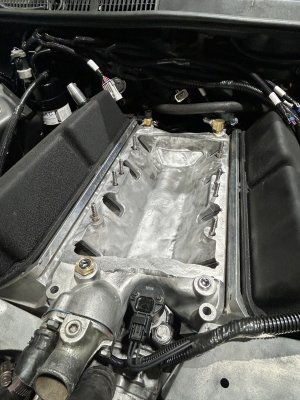
I then had a few aluminum plates plasma cut from send cut send to make a mid plate with injector holes I drilled and a custom welded intercooler.
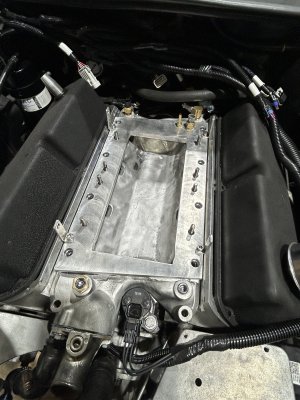
Had this intercooler welded locally with a Bell intercooler core.
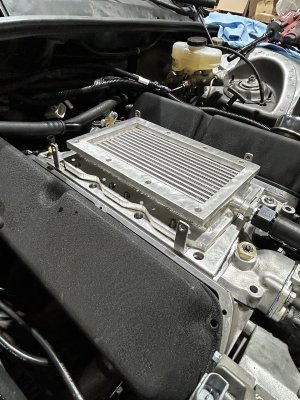
Had to do a bit of work to the supercharger case on the milling machine, had to mill off the side flanges and drill and tap the case to install mounting studs.
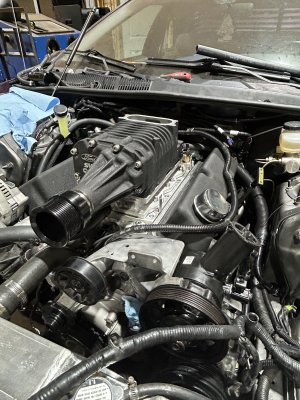
The intercooler is also plumbed to a smaller radiator by my main radiator with a 6 gpm pump.
Had a custom inlet manifold for the supercharged welded so I can use a holley 92mm TB.
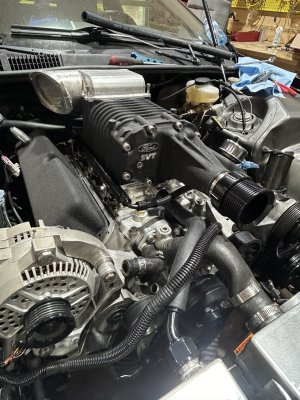
Running some bosch 52 lbs injectors I had laying around for this setup.
My coil on plug setup uses D510C LS coils that I made brackets to mount behind the heads to try and hide them.
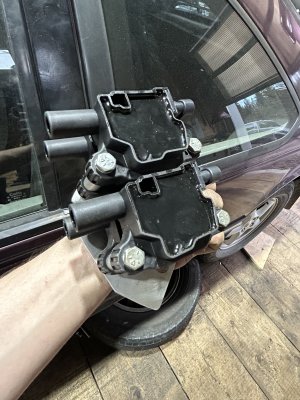
Made a custom crank trigger wheel setup too that uses a professional product balancer, a plasma cut 36-1 trigger wheel and a spacer I made on the lathe to locate the pulley and trigger wheel. Tried using an explorer VR crank sensor but had issues so I switched to holley hall effect crank sensor and no issues since.

I then wired up my terminator x setup and did lots of tuning and it is finally running! I am pushing around 7 psi with my pulley setup (crank 6.5” and sc 2.8” 10 rib for future wider belt). I will hopefully soon bring it to a dyno to get some numbers and a better tune as my current tune is not perfect but it runs and drives for now!
Heres the final results for now, I still have to make an intake tube and do a few touch ups.
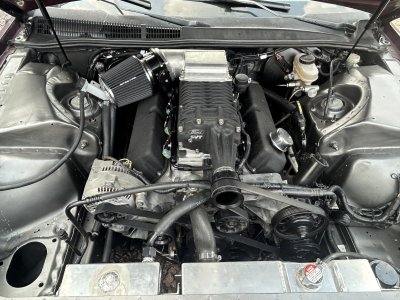
Additional notes :
-Also installed a comp 35-312-8 Cam while i was at it
-Installed AJE 10R motor mounts for the k member (lowered 3/4” from the ones that came with k member)
-VMP pulley hub with 2013-2014 gt500 pulley ran backwards to stick out more
-Everything cleared the stock hood but the pulley was 1/8th too tall so I had to make a cutout to clear the pulley (planning on getting a fiberglass hood with scoop anyways)
Im sure I am missing alot of other things I did for this setup but heres a general update for now, this was my dream setup a few years ago and I put alot of effort to accomplish this, it may not be the best but it works for now and this car is always a work in progress and a platform for me to learn with and making a very custom setup like this at home is a big accomplishement for me and I am thrilled to be driving it now!
Big changes, I ended up making a whole intercooled setup for a m112 ford lightning supercharger to fit on top of my 5.0 engine.
Im now running a terminator x ECU, LS coil on plug setup with an explorer cam sync sensor.
It was alot of work, cut out an air gap intake manifold, machined it on my milling machine.

I then had a few aluminum plates plasma cut from send cut send to make a mid plate with injector holes I drilled and a custom welded intercooler.

Had this intercooler welded locally with a Bell intercooler core.

Had to do a bit of work to the supercharger case on the milling machine, had to mill off the side flanges and drill and tap the case to install mounting studs.

The intercooler is also plumbed to a smaller radiator by my main radiator with a 6 gpm pump.
Had a custom inlet manifold for the supercharged welded so I can use a holley 92mm TB.

Running some bosch 52 lbs injectors I had laying around for this setup.
My coil on plug setup uses D510C LS coils that I made brackets to mount behind the heads to try and hide them.

Made a custom crank trigger wheel setup too that uses a professional product balancer, a plasma cut 36-1 trigger wheel and a spacer I made on the lathe to locate the pulley and trigger wheel. Tried using an explorer VR crank sensor but had issues so I switched to holley hall effect crank sensor and no issues since.

I then wired up my terminator x setup and did lots of tuning and it is finally running! I am pushing around 7 psi with my pulley setup (crank 6.5” and sc 2.8” 10 rib for future wider belt). I will hopefully soon bring it to a dyno to get some numbers and a better tune as my current tune is not perfect but it runs and drives for now!
Heres the final results for now, I still have to make an intake tube and do a few touch ups.

Additional notes :
-Also installed a comp 35-312-8 Cam while i was at it
-Installed AJE 10R motor mounts for the k member (lowered 3/4” from the ones that came with k member)
-VMP pulley hub with 2013-2014 gt500 pulley ran backwards to stick out more
-Everything cleared the stock hood but the pulley was 1/8th too tall so I had to make a cutout to clear the pulley (planning on getting a fiberglass hood with scoop anyways)
Im sure I am missing alot of other things I did for this setup but heres a general update for now, this was my dream setup a few years ago and I put alot of effort to accomplish this, it may not be the best but it works for now and this car is always a work in progress and a platform for me to learn with and making a very custom setup like this at home is a big accomplishement for me and I am thrilled to be driving it now!
Last edited:
- Joined
- Sep 22, 2023
- Messages
- 1,461
- Location
- Waterloo, Iowa
- Cars in Garage
- 1
- Vehicle Details
- 1991 Mercury Cougar LS 5.0
That's a lot of work, but it turned out awesome looking! Hopefully there's enough boost that is fun to drive, too?!
Similar threads
-
-
New here, found this while looking for suspension options
- Started by LoganB
- Replies: 8
-
-
How much to sell my brother's '01 Grand Prix GT for that needs engine?
- Started by FordMan77
- Replies: 9
-
